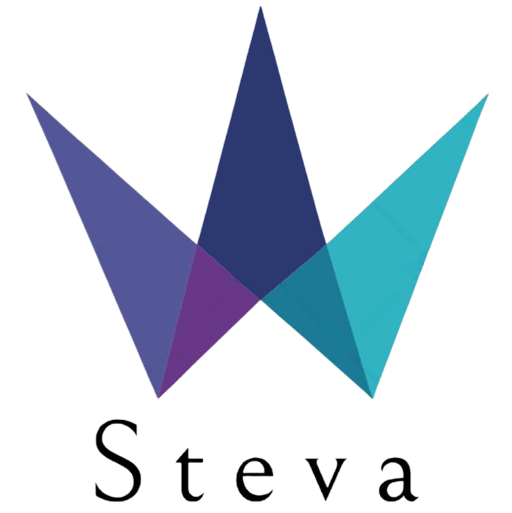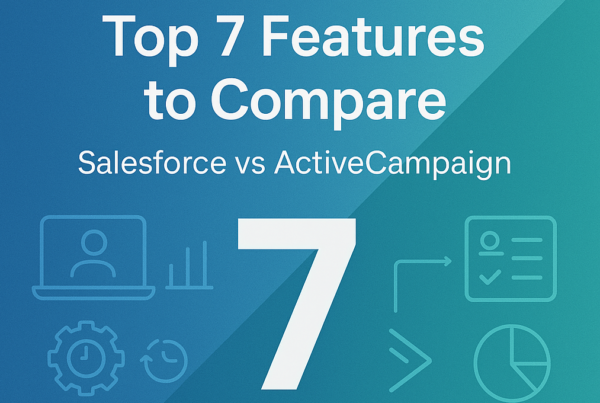Leadpages and Unbounce offer distinct approaches to creating landing pages. Unbounce has operated since 2010 and specializes in AI-powered conversion optimization. Leadpages launched in 2013 to create a more straightforward and affordable landing page builder. The pricing reflects this difference; Leadpages starts at $37 per month, and Unbounce’s entry plan costs $90 per month. Both platforms pack impressive features for creating landing pages from basic to advanced. The AI features in Unbounce boost conversions by 30%. Leadpages gives you access to over 220 professional templates and connects with more than 90 marketing tools. You’ll need to consider your priorities; Leadpages works best if you want simplicity and affordability, while Unbounce excels at AI-driven optimization and higher conversion rates.
Core Focus: Conversion Optimization vs Simplicity
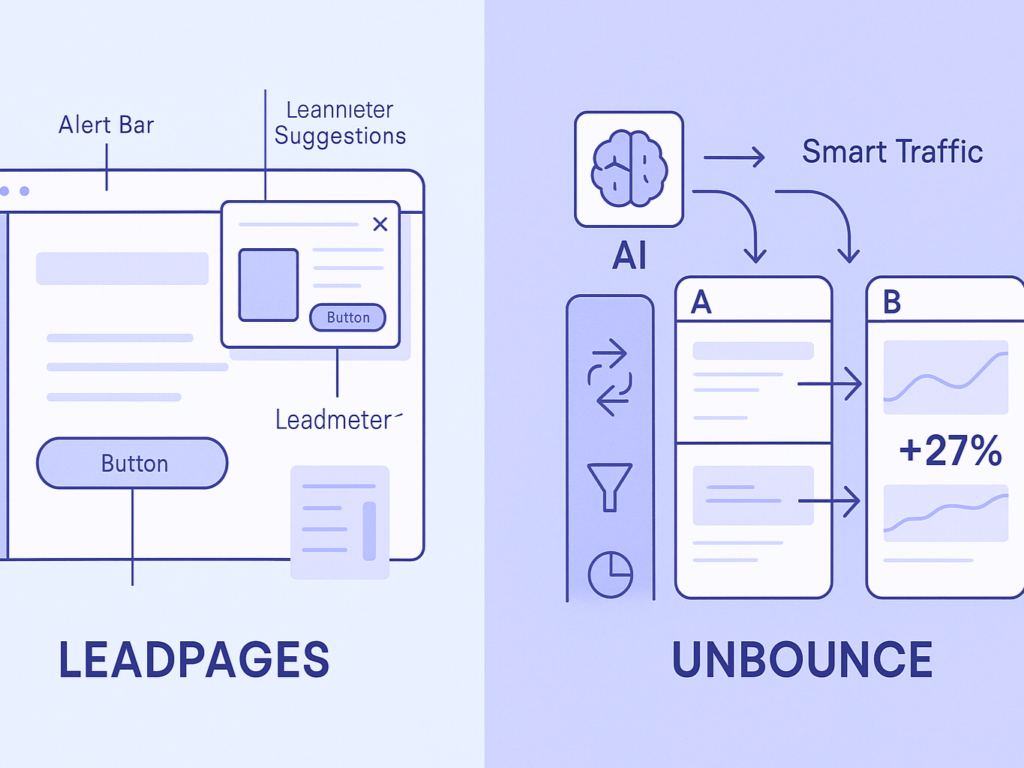
These landing page builders differ fundamentally in their core philosophy. Both platforms want to convert visitors into leads, but take unique paths toward this goal.
1. Leadpages: Built for speed and ease of use
Leadpages is a true conversion platform where every feature serves one purpose: transforming traffic into leads and sales. The platform keeps things simple and accessible, unlike complex page builders. Users get a grid-based, beginner-friendly editor that makes landing page creation easy, even without design experience.
Leadmeter shines as the platform’s standout feature. This real-time optimization tool predicts page performance and suggests improvements before publication—this built-in conversion guidance benefits beginners who might not grasp conversion rate optimization principles.
The platform loads pages faster than its competitors during tests. Quick loading speeds boost conversion rates because visitors stick around longer.
Business owners who need quick implementation can use the following:
- Alert bars to promote lead magnets and special offers
- Pop-ups that grab attention upon arrival or exit
- Easy payment integration through Stripe
- Lead magnet delivery via welcome emails
The platform excels at the DIY approach. Users can create pages without help from consultants or developers. Small businesses and solopreneurs love this simplicity when they need effective landing pages without technical hassles.
2. Unbounce: Designed for AI-driven conversion performance
Unbounce takes a different approach by maximizing conversions through artificial intelligence and advanced customization. The platform leads the pack as the only landing page builder with AI conversion optimization that consistently improves campaign performance by an average of 30%.
Smart Traffic, Unbounce’s flagship AI feature, sends visitors to landing page variations where they convert best based on their traits and behavior. The system starts optimizing after just 50 visits and can boost conversions by up to 20%.
The platform includes AI Copywriting that creates headlines and content for landing pages. Marketers make better decisions thanks to artificial intelligence throughout the platform.
Unbounce gives users a free-form editor with advanced controls. While it might seem complex at first, it provides excellent design freedom. Experienced marketers and agencies love this approach when creating custom landing pages.
The AI conversion optimization tools analyze vast amounts of data through complex algorithms to spot patterns human marketers might miss. The system improves with each interaction, always showing visitors the best-performing pages.
Unbounce brings sophistication to landing page creation by using artificial intelligence to remove guesswork from conversion rate optimization.
Pricing Breakdown: Leadpages vs Unbounce Plans
The price tag plays a vital role in choosing between Leadpages and Unbounce. Your budget limits can greatly affect which platform works best for your business needs beyond features and capabilities.
1. Leadpages pricing tiers: Standard vs Pro
Leadpages keeps its pricing simple with two main plans and an Advanced option for enterprise users. The Standard plan costs $37/month with an annual payment (or $49/month). This starter package has:
- One website/domain
- Unlimited landing pages, pop-ups, and alert bars
- Unlimited traffic and leads
- Free hosting
- Mobile-responsive templates
- 40+ standard integrations
Looking at Leadpages pricing, the Pro plan is $74 per month when billed annually, or $99 monthly. It includes all Standard features, plus advanced tools like A/B testing and online sales payments.
- Three websites/domains
- Unlimited A/B split testing
- Online sales and payment capabilities
- Email trigger links
- 10 opt-in text campaigns
- Email and chat support
Enterprise customers can opt for the Advanced plan with custom pricing, up to 50 sites, five sub-accounts, and priority support. Leadpages gives you a 25% discount if you choose yearly billing instead of monthly. Each plan includes a 14-day free trial and a 7-day money-back guarantee.
2. Unbounce pricing tiers: Launch, Optimize, Accelerate
Unbounce has a more detailed pricing structure with three main public plans and a Concierge option.
(i) The Launch plan
The Launch plan (previously built) starts at $74/month yearly ($99/month monthly). This plan has:
- Unlimited landing pages, pop-ups, and sticky bars
- Up to 500 conversions
- 20,000 unique visitors monthly limit
- One domain
(ii) The Optimize plan
The Optimize plan (previously Experiment) costs $112/month yearly ($149/month monthly). You’ll get:
- Everything in the Launch plan
- Unlimited A/B testing
- Up to 1,000 conversions
- 30,000 unique visitors monthly
- Five domains
(iii) The Accelerate plan
The Accelerate plan costs $187/month yearly ($249/month monthly). This plan includes:
- All Optimize features
- Up to 2,000 conversions
- 40,000 unique visitors monthly
- Ten domains
- Advanced Targeting
- Google AMP pages
Larger businesses needing more traffic and conversion limits can check out the Concierge plan with custom pricing. Unbounce matches Leadpages’ 25% discount for yearly billing compared to monthly payments.
3. Which offers better value for money?
Leadpages are nowhere near as expensive as Unbounce. The basic Standard plan ($37/month yearly) costs less than half of Unbounce’s launch plan ($74/month yearly).
Leadpages’ most significant advantage is its unlimited traffic across all plans. Unbounce limits visitors and conversions, which might lead to extra costs if you exceed these limits.
All the same, Unbounce makes up for its higher price with advanced features like:
- Smart Traffic AI-based visitor routing
- AI copywriting tools
- More flexible design capabilities
- Google AMP page support
Leadpages are of excellent value for budget-conscious users and beginners because of their lower price and unlimited traffic. However, businesses that need conversion optimization and advanced AI features might find Unbounce’s higher cost worth it for the potential ROI from its optimization tools.
Your choice depends on whether you want affordability and simplicity (Leadpages) or are ready to invest more in advanced AI-driven conversion tools (Unbounce).
AI Features: Smart Traffic vs Leadmeter
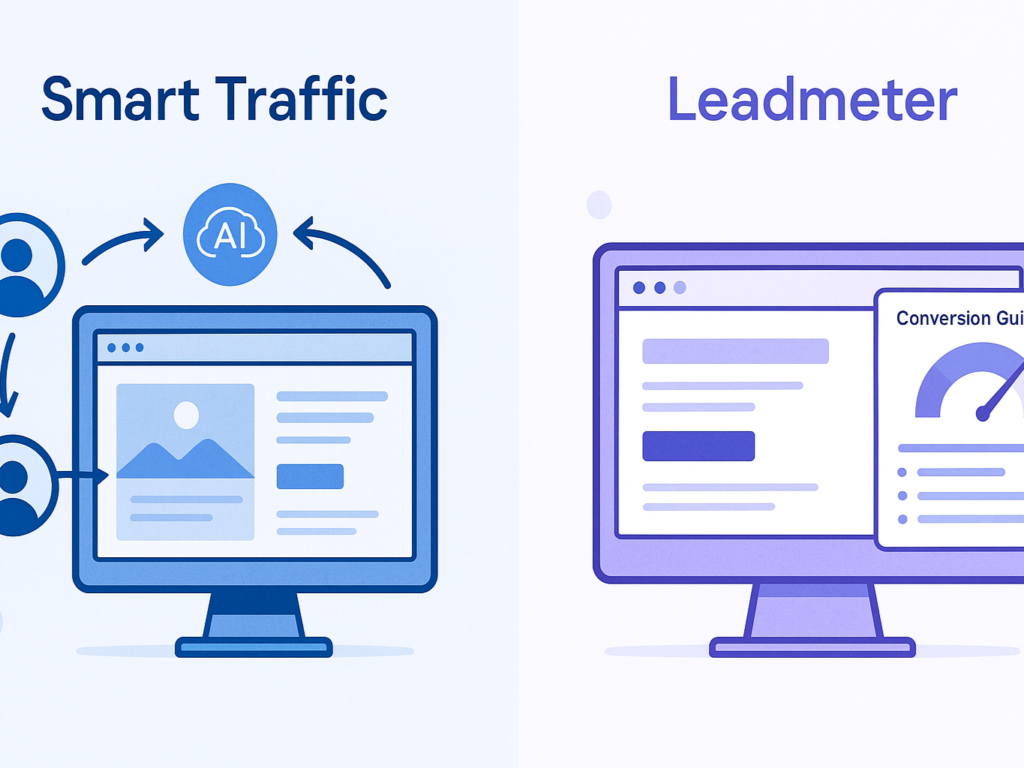
Both platforms use artificial intelligence differently. Unbounce AI features include automated visitor routing and smart content generation to boost conversion rates, while Leadpages focuses on guided page creation for users.
1. Unbounce Smart Traffic: AI-based visitor routing
Smart Traffic is an AI-powered algorithm that matches visitors to landing page variants where they’ll likely convert. Traditional A/B testing picks one “winner,” but Smart Traffic knows different visitors respond better to different page versions based on their unique traits.
The system looks at visitor characteristics such as:
- Location and timezone
- Device type and screen size
- Browser and operating system
- Entry path and time of visit
Smart Traffic starts optimizing after just 50 visits, which makes it much faster than regular testing methods. The system learns and adapts continuously, sending new visitors to their best-matching page variants without manual work.
Companies using Smart Traffic see their conversions jump by 30% compared to standard methods. This boost comes from the system’s ability to spot visitor patterns that human marketers could never find or act on.
Smart traffic makes testing simple. You create page variants, turn on the feature, and let AI handle the rest.
2. Unbounce AI Copywriting: Auto-generate headlines and content
Bright Copy works alongside Smart Traffic as an AI-powered writing tool that creates professional marketing content quickly. This tool helps create, remix, and expand CCopy for landing pages and marketing materials.
Bright Copy has these main features:
- Expander: Create the following sentence or paragraph from your existing text
- Remix: Creates fresh content from existing Copy for different channels or campaigns
- Writer: A long-form writing space without limits for creating detailed content
Bright CCCopyorks with 45+ content templates for various marketing needs. It supports six languages: English, Spanish, German, French, Portuguese, and Dutch. Users can access these AI writing features through a Chrome extension, even while working on other platforms. These tools, combined with Unbounce AI features, offer marketers a powerful set of resources for generating high-converting content effortlessly.
Bright Copy uses content profiles with information about your company and audience to ensure the content matches your brand’s voice.
3. Leadpages Leadmeter: Real-time conversion guidance
Leadpages takes a different path with Leadmeter – a conversion assistant built into their page editor. Instead of optimizing after publishing, Leadmeter helps during the design process.
Leadmeter analyzes your page content live, compares it with thousands of successful pages in their database, and shows you how to boost conversion potential. Your conversion score updates instantly when you make changes, giving you quick feedback on your design choices.
Leadmeter reviews several parts of your page:
- Layout: Structure and element positioning
- Call-to-Action: Button placement, visibility, and messaging
- Readability: Text formatting and content clarity
- Opt-in Form: Field count and form design optimization
The tool gives specific, practical suggestions for your page. It might tell you to reduce form fields or move your CTA button for better results.
Leadmeter acts as your personal conversion expert. It removes the guesswork and helps you use proven marketing strategies without needing advanced expertise. Pages built with Leadmeter convert three times better than industry averages.
Unbounce focuses on optimization after publishing and content creation. Leadpages helps you before publishing and implements best practices. Your choice depends on whether you want ongoing optimization or help during the initial setup.
Page Builder Experience: Drag-and-Drop Comparison
The page builder’s interface is key to how quickly you can create landing pages. A close look at both platforms reveals key differences in their drag-and-drop experience.
1. Leadpages: Grid-based, beginner-friendly editor
Leadpages uses a well-laid-out grid system with sections, rows, and columns that help content fit perfectly. This setup makes the tool easy to use for beginners who don’t have much design experience. You pick a template and change it using a simple layout panel that gives you options for:
- Page layout: Building your grid structure with rows and columns
- Widgets: Adding elements like opt-in forms and buttons
- Page tracking: Adding analytics code and simple SEO settings
- Page styles: Changing fonts and background images
This structured approach means “literally anyone can use Leadpages to build and publish a landing page in one day or less.” The grid system lines up elements professionally without needing design skills.
The guided approach comes with its limits. Some users say the grid system isn’t always perfect when they want to place elements in exact spots.
2. Unbounce: Free-form editor with advanced controls
Unbounce offers a fundamentally different “freeform” editor that lets you put elements anywhere on the page. This freedom gives you more design options, but you must pay attention when placing elements.
The editor has a built-in Widget Panel that stays with you while editing. You can add key elements with one click. Want to move widgets around? Just drag them up or down without removing them first.
On top of that, Unbounce shines with its technical options. You’ll see detailed properties on the right panel when you select elements. This gives you exact control over everything, from size to form confirmations and field settings. Developers will like that the platform works with custom HTML without complex code changes.
3. Mobile editing and responsiveness
Both platforms put mobile optimization first, but they handle it differently. Leadpages creates mobile-friendly pages automatically and shows you how they’ll look during editing. However, you can’t fully control how elements appear in the mobile version. This might hurt conversion rates as mobile traffic keeps growing.
Unbounce gives you more detailed mobile editing options. Their website states, “Unbounce’s mobile editing is very intuitive.” You can edit pages for different screen sizes (desktop, tablet, mobile) to ensure they look great everywhere. You can also show or hide sections based on the device type.
Marketers who care about mobile conversion rates might find Unbounce’s detailed mobile control worth the higher price, even though Leadpages is more manageable for beginners.
Template Libraries and Customization Options
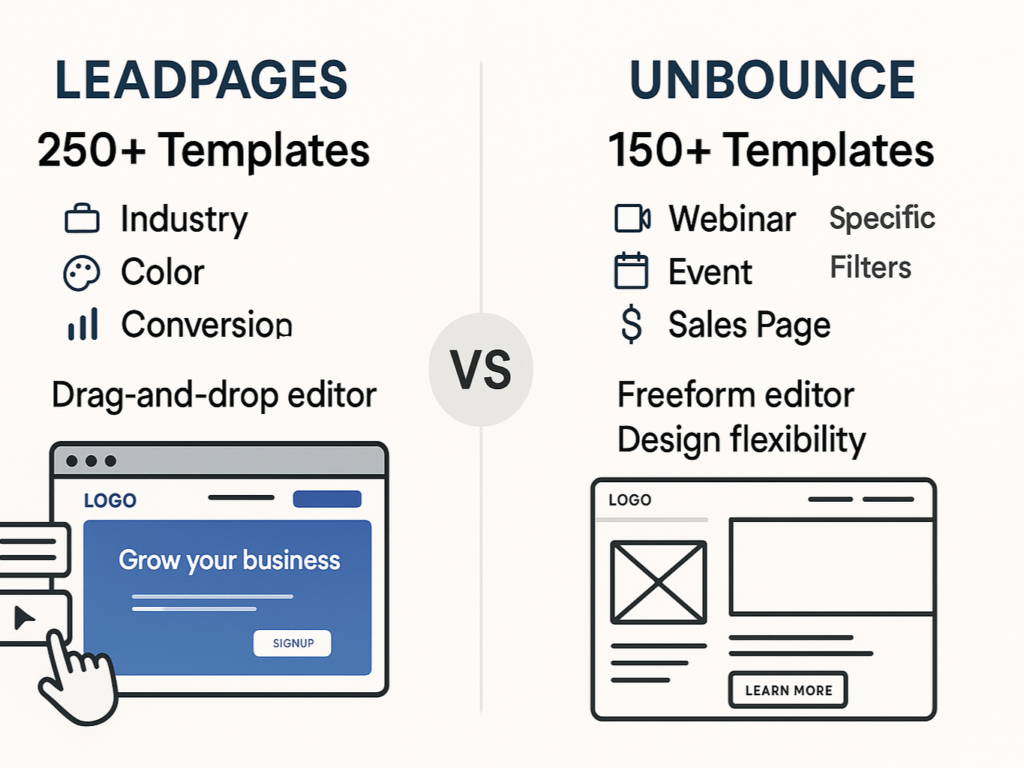
Template selection is the foundation of any landing page project. Both platforms give you extensive libraries to kickstart your designs. The fundamental differences between these tools are shown in their filtering capabilities and customization options.
1. Leadpages: 250+ templates with conversion filters
Leadpages has an impressive library of over 250 professionally designed templates. These templates are built for conversion based on ten years of analytical insights and experience. The collection has landing page templates and more than 50 website templates.
The template library stands out because of its unique filtering system. You can sort templates by:
- Industry specifics (marketing, automotive, real estate, finance)
- Style and color priorities
- Conversion rate performance
The ability to filter templates by actual conversion performance helps you find designs that convert best. These analytical insights show that Leadpages templates “convert 5x better than the industry average”.
Every template adapts to different screen sizes automatically. You can also show or hide specific sections based on the viewing device. This gives you complete control over how your pages look on mobile.
2. Unbounce: 150+ templates with campaign filters
Unbounce has 150 landing page templates. These are organized into landing page templates, sticky bar templates, pop-up templates, and AMP-specific designs.
The template library organization takes a different approach. While it doesn’t have conversion-rate filtering, you can sort designs by:
- Industry relevance
- Campaign type (webinars, events, sales pages)
- Name, recency, and popularity
This campaign-focused filtering makes finding templates that match your marketing goals easy. The templates work smoothly across platforms and integrate well with WordPress sites.
3. Customization flexibility and design control
Both platforms let you customize templates extensively through their drag-and-drop editors. Each takes its approach to design control.
Leadpages keeps things simple with its grid-based system. You can customize templates “with a few clicks of your mouse.” This works great for beginners who need quick results without design skills. The platform’s pre-designed section templates for bios, benefits, and testimonials can go anywhere on the page.
Unbounce focuses on design freedom with its freeform editor. You get precise control over element positioning and detailed customization. The platform gives you more creative control over the final design, though learning takes a bit longer.
Your choice depends on what matters most to you: Leadpages, with its structured templates and proven conversion metrics, or Unbounce, with its design flexibility and campaign-specific templates.
Analytics and A/B Testing Capabilities
When creating effective landing pages, analytics, and testing capabilities are vital differentiators between Leadpages and Unbounce.
1. Leadpages: Simple split testing and visual analytics
Leadpages gives you straightforward analytics that display performance metrics in detail. You can learn about statistics for your pages and pop-ups, including unique views, total views, conversions, and overall conversion rate. The platform lets you see hourly analytics from the last week and daily analytics from the past three months.
Split testing (A/B testing) comes only with Pro and Advanced plan subscriptions. This feature lets you:
- Compare different page layouts, templates, headlines, or button colors
- Distribute traffic between variations based on your priorities
- Track which elements generate the most conversions
Leadpages’ split testing takes a traditional approach where you create variations, split traffic, and find a single winner. You should limit each test to one or two variables to pinpoint which changes boost performance. Once you have enough data, you can send all traffic to your best-performing version.
Leadpages also includes a reset analytics feature. This gives you a fresh start for new experiments after redesigning elements and helps you see how specific changes affect your conversion rates.
2. Unbounce: Advanced A/B testing and Smart Traffic insights
Unbounce enhances analytics with reliable A/B testing capabilities and AI-powered optimization. Like Leadpages, you’ll need a higher-tier plan to access A/B testing since the entry-level Launch plan doesn’t include it.
The testing tools let you compare variations of:
- Headlines and subheadings
- Page length and structure
- Call-to-action button size, position, color, and shape
Unbounce’s Smart Traffic goes beyond traditional A/B testing. This AI-powered conversion tool revolutionizes the testing approach. Rather than picking one winner, Smart Traffic understands that different visitors convert better on different page versions based on their characteristics.
Smart Traffic looks at visitor attributes like device type, location, operating system, and browser to spot conversion patterns. The system starts directing visitors to their most likely converting page variant after just 50 visits. This can boost conversions by up to 20%.
This approach solves problems that conventional A/B testing doesn’t deal very well with, since traditional testing picks just one winning variation. Smart traffic keeps optimizing with up-to-the-minute data analysis, so marketers don’t need to analyze complex test results manually or have advanced statistical knowledge.
Both platforms offer key conversion tracking features. However, Unbounce’s AI-driven approach usually delivers better conversion optimization for marketers who can invest in higher-tier plans.
Integrations and Ecosystem Support
Marketing teams can boost their workflow and campaign results by connecting landing pages with key business tools.
1. Leadpages integrations: CRM, email, ads
Leadpages natively connects with more than 90 popular marketing tools and links to 2,000+ additional services through Zapier. The platform makes lead generation simple with tools of all types:
Your CRM system works better with Leadpages’ direct connections to major platforms like Salesforce, Keap Max Classic (formerly Infusionsoft), and Zoho CRM. Contact details from landing pages flow right into your customer relationship management system.
Email marketing becomes easier with Leadpages’ integrated support for many providers:
- Major providers: Mailchimp, ActiveCampaign, AWeber, and Constant Contact
- Specialized services: Drip, ConvertKit, GetResponse, and Emma
- Automation capabilities: Tags and segmentation options in select integrations
The platform supports marketing automation tools like HubSpot, Marketo, and Ontraport. This helps create targeted follow-up sequences based on how visitors interact with landing pages. These tools turn customer data into tailored marketing campaigns.
2. Unbounce integrations: Broader native and Zapier support
Unbounce connects with 116 tools directly, covering almost every business and marketing tool. The platform stands out by creating uninterrupted workflows between tools.
Users can access over 60 Zapier-powered integrations right inside Unbounce. This lets you send leads from landing pages, pop-ups, and sticky bars to your favorite tools without switching platforms. You also get access to 5,000+ apps through Zapier’s whole interface.
The platform links smoothly with CRM and marketing automation tools like HubSpot, Salesforce, Marketo, etc. Analytics users benefit from strong support from the Google ecosystem, including Google Analytics, Google Tag Manager, and Google Ads integrations.
Google Analytics 4 integration helps track landing page performance right inside Unbounce. Setting up integrations is simple through the “Integrations” tab in the page overview. Field mapping features ensure data moves correctly between systems.
Unbounce provides more native integrations and advanced setup options. Leadpages excels at making connections simple with popular marketing tools.
Performance and SEO Readiness
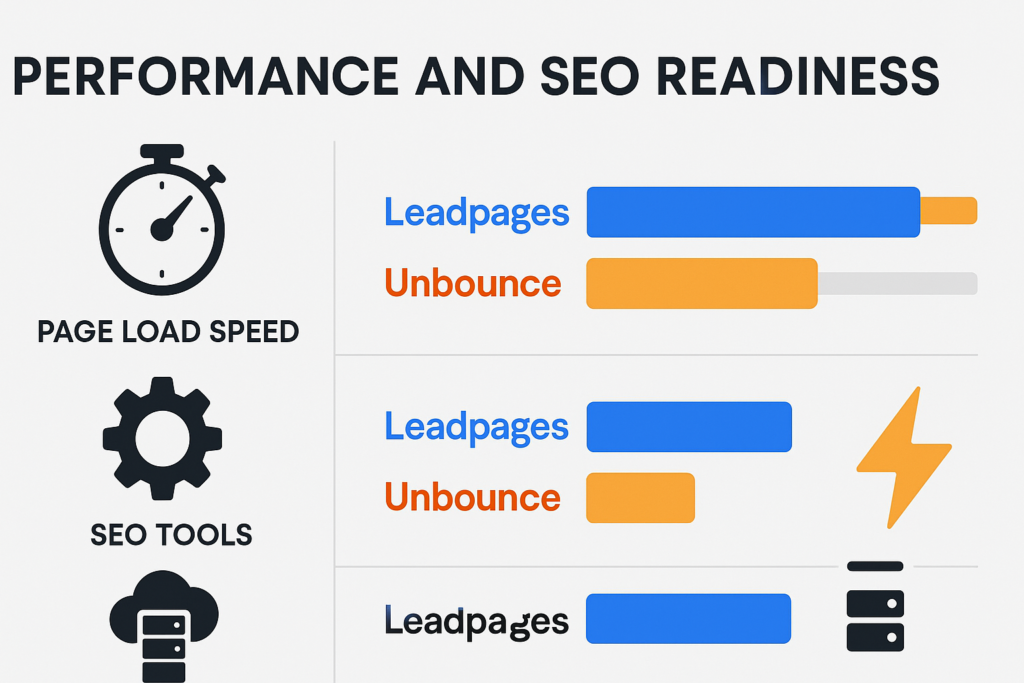
The technical performance of your landing pages shapes visitor experience and conversion rates. Both platforms excel in speed, SEO, and reliability, each with its advantages.
1. Page load speed: Leadpages vs. Unbounce
Load time affects how users participate on your site. Every second of delay can reduce conversion rates by about 7%. Leadpages stands out with industry-leading page load speed that’s faster by 2.4 seconds on average compared to competitors. This speed boost helps SEO rankings, cuts bounce rates, and drives more conversions.
Unbounce makes up for being slower with specialized features. Their AI conversion tools help improve campaign performance by about 30%.
2. SEO tools and AMP support
Both platforms let you customize metadata easily. You can edit meta titles, keywords, and descriptions from each builder’s page properties panel.
Unbounce has an edge with AMP landing pages (Accelerated Mobile Pages). These pages load up to 85% faster than standard mobile pages. Your listing gets a distinctive gray lightning-bolt logo in Google mobile search results. This can boost visibility and click-through rates.
Leadpages relies on exceptional page speed as its main SEO advantage. Site speed remains a vital ranking factor in search algorithms.
3. Uptime and hosting reliability
Unbounce’s hosting infrastructure provides 99.96% uptime. This makes them one of the most reliable landing page hosts. Their servers deliver content fast and include free hosting with all pricing packages.
Leadpages works with Google Cloud services and maintains 99.9% uptime. They utilize Google’s infrastructure instead of running their server network.
Both platforms give you:
- Free hosting on their servers
- SSL certificates to keep data secure
- Custom domain options
Users without websites can get free subdomains from either service. This saves hosting costs while keeping everything professional and secure.
LeadPages vs. Unbounce Pros and Cons
Let’s break down the strongest features and limitations of both platforms. This comparison will help you pick the right landing page builder that matches your needs.
Leadpages Pros:
- Budget-friendly, starting at just $37/month compared to Unbounce’s $74/month entry point
- Simple to use with an easy-to-use interface that works great for beginners
- Quick setup process that lets you build professional pages in hours without design experience
- Feature-rich yet simple, with SMS marketing, alert banners, and pop-ups, don’t overwhelm users
- Excellent template variety with over 200 designs that include proven conversion practices
Leadpages Cons:
- Grid-based editor limitations that can make elements snap to unwanted positions
- Standard templates lack customization options despite marketing claims
- Form functionality restrictions that prevent the embedding of optimized custom forms
- Mobile responsiveness control offers simple options without detailed editing capabilities
- Premium templates need an extra payment beyond subscription fees
Unbounce Pros:
- Superior AI optimization through Smart Traffic that routes visitors to their ideal page variation
- Flexible design freedom with a true drag-and-drop editor for exact element placement
- Dynamic text replacement that enhances paid search campaigns with customized content
- Advanced A/B testing on higher-tier plans with detailed analytics
- Accelerated Mobile Pages (AMP) support for faster mobile loading
Unbounce Cons:
- Higher price point that might not work for solopreneurs and small businesses
- Traffic and conversion limits on all plans, unlike Leadpages’ unlimited offerings
- The steeper learning curve requires more time to learn all the features
- Dashboard navigation seems cluttered and harder to use than competitors”
- Complex builder interface that new users might find challenging
Your choice depends on what matters most to you. Leadpages is affordable and straightforward, perfect for beginners and budget-conscious users. Unbounce shines with better conversion optimization and design flexibility, making it ideal for experienced marketers who need advanced features.
Leadpages vs Unbounce: Landing page builder comparison
This landing page builder comparison table makes understanding the key differences between Leadpages and Unbounce easier. Quickly scan features, pricing, and unique strengths to decide which platform fits your marketing goals best.
| Feature/Aspect | Leadpages | Unbounce |
| Starting Price | $37/month | $74/month |
| Core Focus | Simplicity and affordability | AI-powered conversion optimization |
| AI Features | Leadmeter (up-to-the-minute optimization guidance) | Smart Traffic (AI routing) + AI Copywriting |
| Templates | 250+ templates | 150+ templates |
| Page Builder | Grid-based, well-laid-out editor | Free-form editor with advanced controls |
| Traffic Limits | Unlimited traffic on all plans | Limited by plan (20,000-40,000 visitors) |
| Conversion Rate | 5x better than industry average | Up to 30% improvement with AI features |
| Mobile Editing | Basic responsive design | Advanced mobile-specific editing |
| Integration Count | 90+ native + 2,000 via Zapier | 116 native + 5,000 via Zapier |
| Page Load Speed | 2.4 seconds faster than average | Standard with AMP support |
| Uptime | 99.9% | 99.96% |
| Best For | Beginners, small businesses | Experienced marketers, agencies |
| Key Advantage | Simplicity and affordability | Advanced AI optimization |
| Biggest Limitation | Limited design flexibility | Higher cost, steeper learning curve |
Conclusion
Leadpages vs Unbounce shine in different areas, making them suitable for various business needs. Leadpages impresses users with its affordable starting price of $37/month. The platform offers a beginner-friendly interface and unlimited traffic in all plans. Its grid-based editor and Leadmeter technology help users create fast, high-converting pages, although design flexibility has some limits.
Unbounce costs $74/month and provides powerful AI features through Smart Traffic and AI Copywriting. These tools improve campaign performance by 30%. The higher price point makes sense for businesses that focus on conversion optimization. The platform’s free-form editor gives users better design control but takes more learning time. The best choice depends on your specific needs. Leadpages works well when you need to watch your budget and want simplicity. Unbounce makes more sense if you need advanced AI optimization and detailed design control.
Our complete testing shows Leadpages works best for solopreneurs and small businesses that need quick, effective landing pages. Unbounce serves marketing teams and agencies better with its sophisticated conversion tools. Both platforms offer 14-day free trials. You can test their features firsthand to see which one works better with your business goals.
FAQs on Leadpages vs. Unbounce
Q1. Which platform is better for beginners, Leadpages or Unbounce?
Leadpages is generally better for beginners due to its more intuitive, grid-based editor and lower starting price. It offers a simpler learning curve and allows users to create professional landing pages quickly, even without design experience.
Q2. How do the AI features compare between Leadpages and Unbounce?
Unbounce offers more advanced AI features, including Smart Traffic for visitor routing and AI Copywriting. Leadpages provides Leadmeter, which offers real-time optimization guidance during page creation. Unbounce AI features focus more on post-publication optimization, while Leadpages emphasizes pre-publication assistance.
Q3. What are the main pricing differences between Leadpages and Unbounce?
Leadpages pricing is more affordable, starting at $37/month with unlimited traffic across all plans. Unbounce begins at $74/month but imposes traffic and conversion limits. Unbounce justifies its higher price with more advanced AI-driven optimization features.
Q4. How do the template libraries compare between the two platforms?
Leadpages offers over 250 templates with conversion rate filtering, while Unbounce provides about 150 templates organized by campaign type. Leadpages templates convert better than industry averages, while Unbounce offers more design flexibility for customization.
Q5. Which platform offers better integration capabilities?
Both platforms offer extensive integrations, but Unbounce generally provides a wider range of native integrations (116) compared to Leadpages (90+). Unbounce also offers more sophisticated setup options, while Leadpages focuses on simplifying the connection process with popular marketing tools. Both platforms support additional integrations through Zapier.
